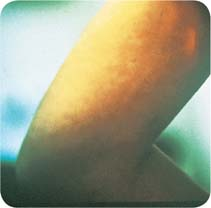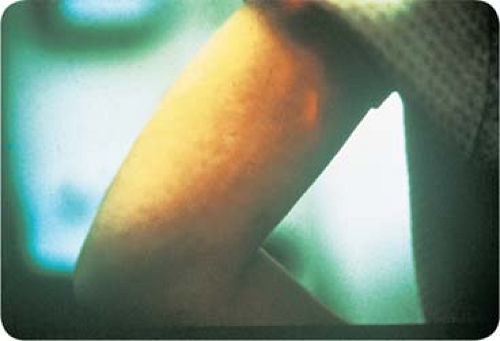Viral Arthritis
Katherine Holman
Martin Rodriguez
 |
A 21-year-old Caucasian woman with no significant past medical history presents with a 3-day history of joint pain and swelling. She states that the symptoms started with fever up to 102°F and diffuse myalgias. The joint pain began abruptly in her knees and spread to involve multiple joints over the next few days. She notes that her pain and stiffness are worse in the mornings. Her social history is significant for working at an establishment that held parties for children. Physical examination is notable for a temperature of 102.7°F, and tenderness to palpation with limited range of motion over knees, wrists, elbows, and proximal interphalangeal (PIP) joints symmetrically. Rash is noted as shown in Figure 25.1. Laboratory data were significant for white blood cell (WBC) 11.3 with a normal differential, erythrocyte sedimentation rate (ESR) 25 mm/hour, and C-reactive protein (CRP) 12.2 mg/L; human immunodeficiency virus (HIV) and hepatitis B and C serologies were negative. Antinuclear antibodies (ANA), anticyclic citrullinated peptide antibodies (anti-CCP), and rheumatoid factor (RF) were negative. Parvovirus IgM and IgG were positive at 3.4 and 5.3 respectively.
Introduction
Viruses affecting humans are ubiquitous, and their clinical syndromes are diverse. Their ability to either cause an acute illness with full recovery or establish a latent course—progressing to a relapsing syndrome or chronic progressive illness—can make their diagnoses difficult (1). Among the wide manifestations of viral illnesses, arthritis is an uncommon symptom; however, in the case of specific viruses, arthritis can be one of the most common symptoms (i.e., alphaviruses). Therefore, various viral illnesses should be considered in the differential diagnosis of a patient presenting with undifferentiated arthritis.
Parvovirus B19
Clinical Presentation
Parvovirus B19 was identified in human serum in the mid-1970s (2). However, its disease manifestations have been recognized since the 1800s, with the initial description of “fifth disease” or erythema infectiosum in children (3). The classic forms of parvovirus B19 infection occur at either the viremic stage (transient aplastic crisis and pure red cell aplasia) or the postviremic stage (erythema infectiosum and arthropathy; 2). While children commonly present with the classic “slapped cheek” and reticular rash of erythema infectiosum, rash is usually absent or subtle in adults (1). Conversely, arthralgias or arthritis is far more common in adults with acute infections (4). The classic arthritis begins precipitously in a few joints, spreads rapidly in 24 to 48 hours, and is characterized by severe, prolonged morning stiffness.
Examination
Patients tend to present with a low temperature. A lacy rash, most commonly present in the extremities, can be found. Tender, swollen joints are commonly seen, but no deformities are present. Both small- and medium-size joints are predominantly affected usually in a symmetrical fashion (1). Axial joints are spared.
Diagnosis
Viremia is evident by 5 to 6 days postexposure, with a peak at 8 to 9 days. The virus clears quickly, and IgM is present by days 10 to 12 and may persist for 2 to 3 months (2). Serum of infected patients can show transient autoantibodies, including, but not limited to, ANA, RF, and anti-DNAs (4). Diagnosis therefore relies on serum IgM antibodies to parvovirus B19, with or without IgG and demonstrable parvovirus DNA.
Treatment
Treatment is supportive, with nonsteroidal anti-inflammatory drugs (NSAIDs) as needed for pain and inflammation. Intravenous immunoglobulin has been used in cases of pure red cell aplasia in immunocompromised patients, but it is not recommended in arthritis (4).
Clinical Points
There is no “classic” presentation that is typical of virally associated arthritis.
Many virally associated arthritides can be mistaken for early rheumatoid arthritis (RA).
Arthritis may occur before the onset of a typical clinical viral syndrome (i.e., HBV, HIV).
Clinical Course
Acute arthritis resolves within weeks although, uncommonly, cases have persisted for months. Whether parvovirus B19 infection causes a chronic arthritis remains controversial (4), as does its possible association with RA and other inflammatory arthropathies. Some studies have found ongoing B19 DNA in serum, bone marrow, and synovium of patients with chronic arthritis and/or RA, but they have been found in healthy controls as well, making a determination of the cause difficult (1,2,4,5,6).
Hepatitis C
Clinical Presentation
Hepatitis C (HCV) is a single-stranded RNA Flavivirus. It is estimated that greater than 170 million people worldwide are infected with the virus (7). Parenteral infection occurs most commonly, often in the setting of intravenous drug use. Transmission in health care settings has become rare in developed countries since routine testing of blood products began in the early 1990s; however, occasional cases continue to be reported (7). Following acute infection with HCV, 74% to 86% of patients develop persistent viremia and 15% to 20% of these patients with chronic infection develop cirrhosis (7), which can progress to hepatocellular carcinoma and end-stage liver disease.
Thorough history, including immunizations, exposures, occupation, travel, sexual, and social.
Close examination for signs of other rheumatologic conditions.
Specific laboratories on the basis of risk assessment above.
Extrahepatic manifestations of HCV infection are varied, with joint pain being a common one. Studies estimate that 9% to 29% of all patients with HCV complain of arthralgias, while 2% to 4% of patients have arthritis (1,8). True inflammatory arthritis appears to manifest in four distinct ways: (1) relating directly to HCV infection (2) as a sign of mixed cryoglobulinemia (3) coexisting, but separate rheumatic disease (4) occurring rarely secondary to therapy for HCV (4). As therapy-related arthritis is exceedingly rare, further discussion of 1 to 3 follows.
HCV-Related Arthritis
Patients can develop an inflammatory arthritis directly related to HCV, which occurs in fewer than 5% of patients (4). Physical examination reveals evidence of synovitis of small joints in a symmetrical pattern.
Diagnosis
Demonstration of HCV antibody or RNA in serum and ruling out other causes of both HCV-related, such as mixed cryoglobulinemia, and nonrelated inflammatory arthritis.
Treatment/Clinical Course
Most commonly used treatments are analgesics and low-dose corticosteroids. Disease-modifying antirheumatic drugs (DMARDs) and biologic agents, such as antitumor necrosis factor (anti-TNF), have also been used, albeit uncommonly (4). Studies of antiviral therapy show mixed results, with evidence of benefit and occasionally exacerbation of symptoms; however, most of these studies did not clearly define if these patients had cryoglobulinemia-related versus HCV-related arthritis (9).
Mixed Cryoglobulinemia
Essential mixed cryoglobulinemia is associated with HCV infection, and symptoms include purpura, glomerulonephritis, lymphadenopathy, skin ulcers, and peripheral neuropathy. Many patients complain of arthralgias; however, less than 10% develop frank arthritis (4). The classic triad is described as that of purpura, glomerulonephritis, and arthralgias. Physical examination seldom reveals evidence of synovitis or deformity; skin examination shows palpable purpura most frequently in the lower extremities.
Diagnosis
Diagnosis requires demonstration of the clinical syndrome in addition to serologic, including serum cryoglobulins, low C4 level, and positive RF (serologic), with histologic findings such as evidence of leukocytoclastic vasculitis (4). Notably, tests for HCV antibodies can be falsely negative in this condition, requiring tests directed toward HCV RNA for diagnosis (7).
Stay updated, free articles. Join our Telegram channel

Full access? Get Clinical Tree









